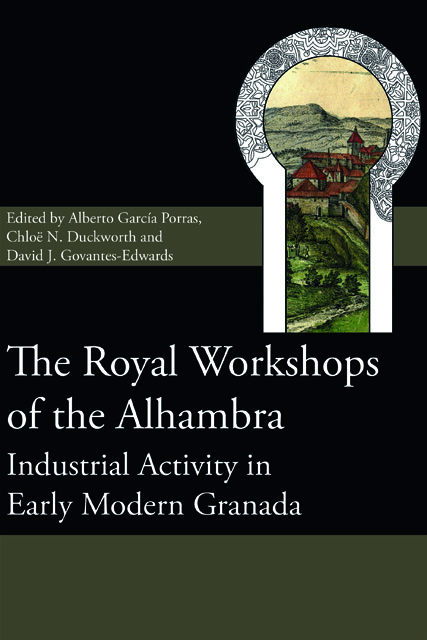Book contents
- Frontmatter
- Contents
- List of Illustrations
- List of Contributors
- Acknowledgements
- Foreword
- Introduction
- 1 The Secano: the city of the Alhambra
- 2 A holistic and reflexive methodology for the archaeological investigation of pyrotechnological activity in the Alhambra
- 3 The modern kilns
- 4 Geophysical and geochemical exploration of the industrial areas in the Alhambra
- 5 The excavation of the area of the Secano in the Alhambra: Trench 1
- 6 The excavation of the area of the Secano in the Alhambra: Trench 2
- 7 The pottery
- 8 Glass in the excavation of the Secano, the Alhambra
- 9 Furnaces at full blast: the demand for architectural ceramics for construction in the Alhambra (16th and 17th centuries)
- Conclusions
- Index
7 - The pottery
Published online by Cambridge University Press: 20 December 2023
- Frontmatter
- Contents
- List of Illustrations
- List of Contributors
- Acknowledgements
- Foreword
- Introduction
- 1 The Secano: the city of the Alhambra
- 2 A holistic and reflexive methodology for the archaeological investigation of pyrotechnological activity in the Alhambra
- 3 The modern kilns
- 4 Geophysical and geochemical exploration of the industrial areas in the Alhambra
- 5 The excavation of the area of the Secano in the Alhambra: Trench 1
- 6 The excavation of the area of the Secano in the Alhambra: Trench 2
- 7 The pottery
- 8 Glass in the excavation of the Secano, the Alhambra
- 9 Furnaces at full blast: the demand for architectural ceramics for construction in the Alhambra (16th and 17th centuries)
- Conclusions
- Index
Summary
The aim of this chapter is to present the medieval, early modern, and modern pottery found during the recent excavations in the Secano of the Alhambra. The analysis of the pottery has been twofold: first, the assemblage was characterized typologically and functionally; second, the clays were analysed by archaeometric methods taking into account mineralogical and geochemical variables, namely X-ray Diffraction (XRD) and Scanning Electron Microscope–Energy Dispersive X-ray Spectroscopy (SEM-EDS). The assemblage found in the Secano appears to confirm that production activities began in the area in the medieval period, became very intensive in the Early Modern Age, and all but ceased in the 18th century. Particularly striking is the virtual absence of high-end medieval ceramics and the enormous increase in pyrotechnological activity in the Early Modern Age. Thin-section analysis, for its part, has yielded important information concerning the technological practices and raw resources available to the craftspeople of the Secano. These studies indicate that the conquest of the Nasrid kingdom of Granada triggered significant technological change and the adoption of new production models. The archaeological and historical analysis of production systems offers a critical perspective on the nature and evolution of interactions between al-Andalus and Castile through the examination of changes in material culture and cultural behaviour over time. The analysis of the ceramics found in the Alhambra has provided a more in-depth perspective on change and continuity in the aftermath of the Castilian conquest.
Keywords: medieval and modern ceramics; ceramic production; typology, archaeometry.
Introduction
The excavation of the area of the Secano in the Alhambra resulted in the collection of a large ceramic assemblage. The analysis of this assemblage has yielded the interesting conclusion that ceramic production in the area was virtually, if not entirely, abandoned in the 18th century, in keeping with the stratigraphic analysis of the two excavation trenches (see Chapters 5 and 6) and the results of archival research. Also in line with the excavation results, the assemblage suggests that the area witnessed substantial production activity in the Early Modern Age.
Methodology
The study of the ceramic assemblage began during the excavation season. After washing, labelling, and joining, diagnostic pieces were catalogued and entered into an ad hoc database. The initial examination consigned such variables as shape, colour of the fabric, clay composition (macroscopic), forming and firing methods, finishing of surfaces, and decoration.
- Type
- Chapter
- Information
- The Royal Workshops of the AlhambraIndustrial Activity in Early Modern Granada, pp. 97 - 134Publisher: Boydell & BrewerPrint publication year: 2022



